Rio Tinto Bundle
Can Rio Tinto Navigate the Future of Mining?
Rio Tinto, a mining giant since 1873, is undergoing a transformative shift, moving beyond its iron ore legacy. This strategic pivot is crucial in an industry increasingly shaped by the global energy transition and the push for sustainable materials. Today, the company's future is being reshaped by its investments in battery metals, innovation, and strategic planning.
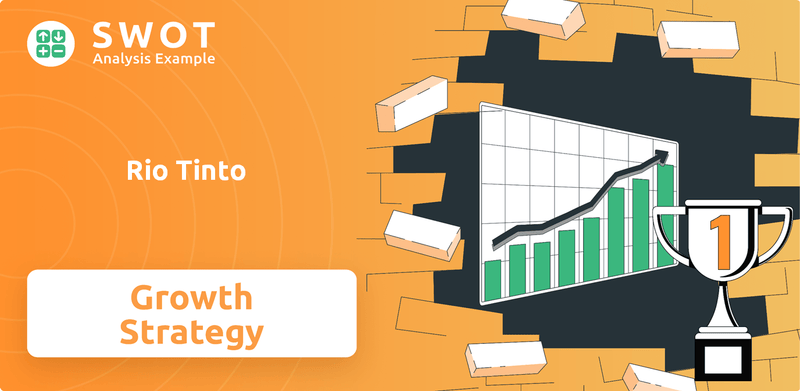
Understanding the Rio Tinto SWOT Analysis is key to grasping its current position and future trajectory. This comprehensive analysis explores Rio Tinto's growth strategy, examining its expansion plans and how it's adapting to mining industry trends and sustainable mining practices. By evaluating its financial performance and long-term growth potential, we can assess Rio Tinto's ability to capitalize on emerging opportunities and overcome challenges in a dynamic market.
How Is Rio Tinto Expanding Its Reach?
Rio Tinto's growth strategy is heavily focused on expanding its operations, particularly in materials essential for the energy transition. The company is strategically diversifying its portfolio to reduce reliance on iron ore and capitalize on the increasing demand for copper and lithium. This approach is designed to ensure long-term sustainability and adapt to evolving market demands.
The company's future prospects are significantly influenced by its strategic acquisitions and investments in key projects. These initiatives are intended to enhance its market position and capitalize on emerging opportunities within the mining industry. The company's commitment to sustainable mining practices and technological advancements further strengthens its growth trajectory.
A comprehensive Rio Tinto company analysis reveals a proactive approach to adapting to market changes. This involves not only expanding into new sectors but also optimizing existing operations and focusing on environmental, social, and governance (ESG) factors. This strategy aims to ensure both financial success and responsible resource management.
Rio Tinto's aggressive expansion into the lithium sector is a key part of its growth strategy. The acquisition of Arcadium Lithium for US$6.7 billion, finalized in March 2025, has positioned the company as the third-largest lithium producer globally. This strategic move provides immediate access to established operations and significantly boosts the company's lithium production capacity.
Rio Tinto plans to significantly increase copper production, aiming for over a 30% boost between 2024 and 2028. The company is targeting an annual production of one million tonnes by the end of the decade. The Oyu Tolgoi underground expansion in Mongolia is a major contributor to this growth, expected to reach full production by 2026.
While diversifying, iron ore remains a significant part of Rio Tinto's portfolio. The company is focused on system-wide improvements in its Pilbara operations. The Simandou project in Guinea is on track for first production in 2025, with full capacity expected by 2028. These initiatives are designed to maintain a competitive edge.
Rio Tinto is investing heavily in various projects to strengthen its position in the market. This includes the Winu copper-gold project in Western Australia and the Resolution copper project in the US. Furthermore, the company is investing in its Kennecott operation in Utah to strengthen copper supply.
These expansion initiatives are crucial for Rio Tinto's long-term growth potential and its ability to adapt to evolving market conditions. The company's focus on materials critical for the energy transition, along with its commitment to operational improvements, positions it well for future success. For a deeper understanding of who Rio Tinto is targeting with these expansions, consider reading about the Target Market of Rio Tinto.
Rio Tinto's expansion strategy focuses on increasing production capacity and diversifying its portfolio. The company is investing in copper and lithium projects to meet growing demand in the electric vehicle and renewable energy sectors. These investments are designed to enhance shareholder value and ensure sustainable growth.
- Acquisition of Arcadium Lithium: Positions Rio Tinto as a major lithium producer with an aim to reach 460,000 tonnes LCE by 2033.
- Copper Production Increase: Targeting one million tonnes annually by the end of the decade, driven by the Oyu Tolgoi expansion.
- Iron Ore Optimization: System-wide improvements in Pilbara operations and the Simandou project to maintain iron ore production.
- Strategic Investments: Focus on projects like Winu and Resolution to strengthen copper supply and meet increasing market demand.
Rio Tinto SWOT Analysis
- Complete SWOT Breakdown
- Fully Customizable
- Editable in Excel & Word
- Professional Formatting
- Investor-Ready Format
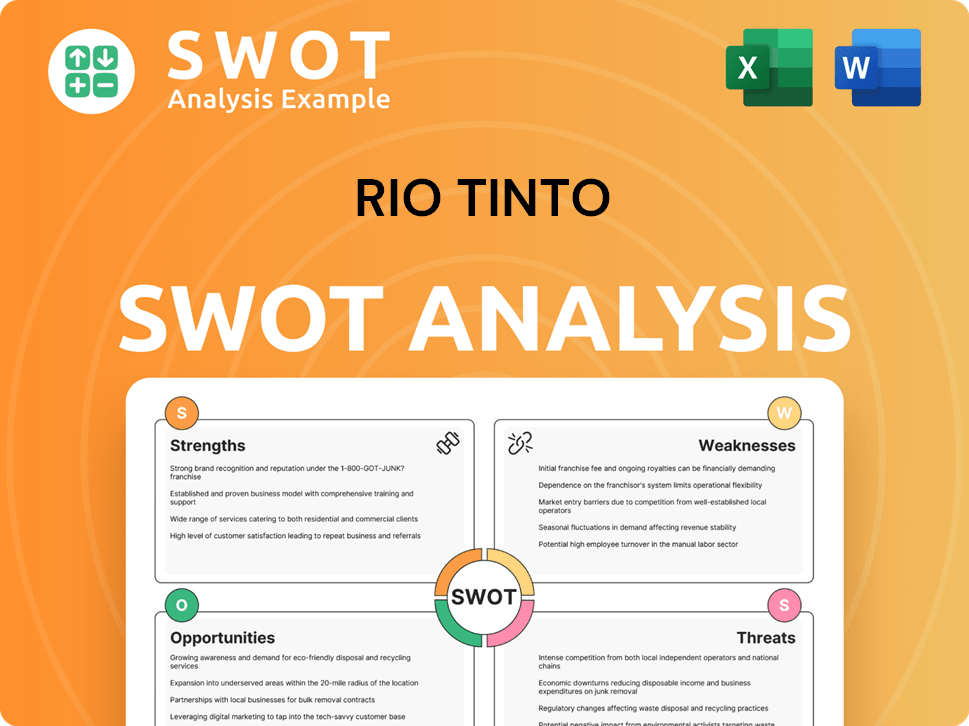
How Does Rio Tinto Invest in Innovation?
To ensure sustained growth, the company actively leverages technology and innovation. This approach is particularly evident in its 'Mine of the Future' initiative and significant investments in decarbonization, which are crucial components of its overall strategy. These efforts are designed to improve operational efficiency and reduce environmental impact, aligning with current Mission, Vision & Core Values of Rio Tinto.
The company's commitment to digital transformation is also noteworthy. The Safe Production System is being rolled out across its operating sites, which is expected to boost production. Furthermore, the company's focus on sustainability and decarbonization is central to its innovation strategy, with ambitious targets set for reducing emissions and increasing the use of renewable energy.
These initiatives are critical for the company's long-term success, as they address key industry trends and stakeholder expectations. By integrating advanced technologies and adopting sustainable practices, the company aims to enhance its competitive advantage and secure its future prospects in the mining industry.
The 'Mine of the Future' initiative integrates advanced technologies. These include autonomous drilling and AI-based predictive maintenance. This aims to reduce energy consumption by up to 15% and enhance recovery rates.
The company is making substantial progress in digital transformation. The Safe Production System was rolled out across approximately 80% of its operating sites by the end of 2024. This contributed to a 5 million tonne production uplift for Pilbara Iron Ore in 2024 for the second consecutive year.
The company has set ambitious targets to reduce absolute Scope 1 and 2 greenhouse gas emissions. The goal is a 15% reduction by 2025 and a 50% reduction by 2030 (compared to 2018 levels). The company aims to achieve net-zero emissions from its operations by 2050.
In 2024, gross operational emissions dropped to 30.7 Mt CO2e. This is a 14% reduction relative to its 2018 baseline. The company plans to invest $5-6 billion by 2030 in projects aimed at reducing CO2 emissions by more than 3 million tonnes annually.
The company is increasing electricity consumption from renewables, which reached 78% in 2024 (up from 71% in 2023). The goal is to surpass 90% by 2030. They signed 2.2 GW in renewable energy Power Purchase Agreements (PPAs) for its aluminum smelters in Australia.
The company is electrifying its mining operations. It is collaborating with partners like Caterpillar and Komatsu to develop battery-electric haul trucks. It is also transitioning 100% of its heavy mining equipment at the Kennecott mine to renewable diesel. Furthermore, it is focusing on developing low-carbon steelmaking technologies, such as BioIron™ and electric smelting.
The company's focus on sustainability is evident in its various initiatives. These include increasing renewable energy use, electrifying mining operations, and developing low-carbon technologies. These efforts are crucial for addressing climate change and meeting stakeholder expectations.
- The company spent $589 million on decarbonization efforts in 2024.
- Scope 3 emissions reached 574.6 Mt CO2e in 2024.
- The company is exploring carbon capture and mineralization technologies. It is partnering with Hydro to evaluate carbon capture for aluminum emissions. It is also planning CO2 mineralization at its ISAL site by 2028.
- The company's investments in electric vehicles and renewable energy are key components of its long-term growth potential.
Rio Tinto PESTLE Analysis
- Covers All 6 PESTLE Categories
- No Research Needed – Save Hours of Work
- Built by Experts, Trusted by Consultants
- Instant Download, Ready to Use
- 100% Editable, Fully Customizable
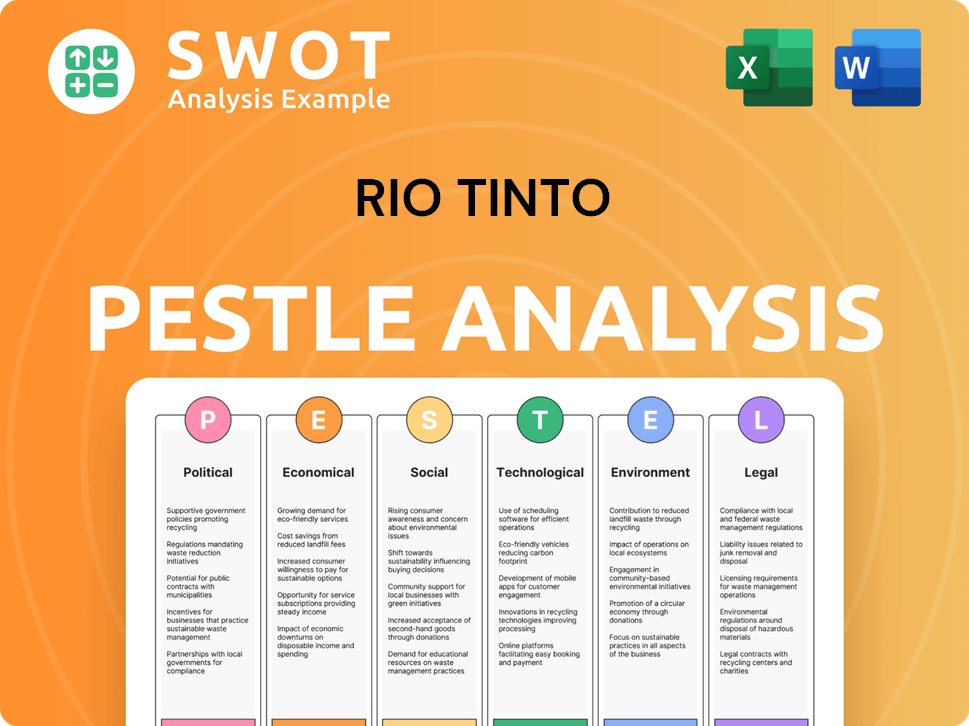
What Is Rio Tinto’s Growth Forecast?
The financial outlook for Rio Tinto in 2025 reflects a strategic pivot towards energy transition materials, alongside significant investments in major projects. This approach is expected to influence the company's financial performance, including both near-term challenges and long-term growth opportunities. The company's focus is on sustainable mining practices and adapting to evolving market dynamics.
For the full year 2024, analysts anticipated revenue of $53.806 billion and earnings per share (EPS) of $6.78, a 6.5% decrease from 2023. Despite these figures, the company is guiding for a 4% volume growth in 2025. The company's strategic investments are aimed at bolstering its position within the mining industry trends.
The company's underlying EBITDA for 2024 was $23.3 billion, with operating cash flow at $15.6 billion, and net earnings attributable to owners of Rio Tinto were $11.6 billion. Net debt increased to $5.5 billion in 2024 due to acquisitions, but remains at comfortable levels. The company is actively working on its marketing strategy to maintain its competitive advantage.
Financial projections suggest a cautious outlook for 2025. Earnings per share are forecast to decline from US$6.67 in 2024 to US$2.57 by 2026, according to Panmure Liberum's May 2025 analysis. UBS projects a fall in net profit after tax (NPAT) to US$10.9 billion in FY25.
Unit costs are projected to rise by 3% year-over-year in 2025, to between US$23 and US$24.5 per tonne. Rio Tinto is guiding for a 4% volume growth in 2025. This growth is supported by the company's expansion plans in Australia and other regions.
Rio Tinto has increased its capital expenditure guidance to $11 billion for the 2025 financial year, a $1 billion increase from previous forecasts. This investment supports projects like the Oyu Tolgoi copper mine and the Simandou iron ore project.
JP Morgan projects a 25-30% EBITDA growth for 2025, primarily due to copper expansion. Analysts have an 'overweight' rating, with a price target of 5,920p. The company maintains a 60% payout for its ordinary dividend, with a full-year ordinary dividend of $6.5 billion in 2024.
The company's financial performance is influenced by several factors, including iron ore prices and its investments in sustainable mining practices. The following points summarize the key financial aspects:
- Revenue: Analysts expected $53.806 billion in 2024.
- EPS: Forecast to decline from US$6.67 in 2024 to US$2.57 by 2026.
- Capital Expenditure: Increased to $11 billion for 2025.
- Dividend: Maintained a 60% payout ratio.
Rio Tinto Business Model Canvas
- Complete 9-Block Business Model Canvas
- Effortlessly Communicate Your Business Strategy
- Investor-Ready BMC Format
- 100% Editable and Customizable
- Clear and Structured Layout
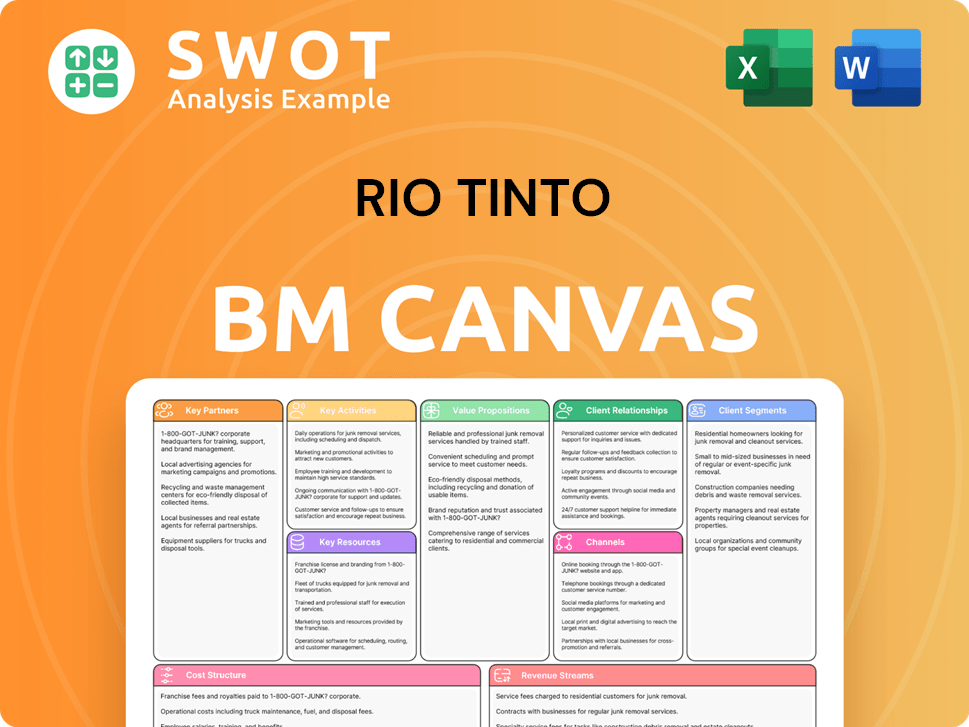
What Risks Could Slow Rio Tinto’s Growth?
The path of the company's growth strategy is not without its challenges. Several potential risks and obstacles could impact its operations and future prospects. Understanding these challenges is crucial for a comprehensive Rio Tinto company analysis.
Market competition, price volatility, and geopolitical factors are significant hurdles. The company also faces scrutiny regarding its environmental and social performance. Navigating these risks requires strategic foresight and robust risk management.
The mining industry trends highlight the importance of adapting to changing conditions. The company is actively working to mitigate these risks through diversification, strategic investments, and a focus on sustainable mining practices.
The company faces intense competition from other major miners. These competitors are also pursuing critical mineral assets, creating a competitive landscape. This competition can affect market share and profitability.
Price fluctuations, especially in lithium, pose a substantial risk. The dramatic 70% price decline in 2023 demonstrates the market's sensitivity. This volatility can significantly impact financial performance.
Operating across multiple jurisdictions exposes the company to various regulatory risks. Proposed lithium export taxes in Argentina's 2025 draft legislation and political instability can affect long-term investment. Geopolitical tensions could also disrupt global operations.
The company faces scrutiny regarding its environmental and social performance. Concerns from local communities and traditional owners about water contamination, tailings dam failures, and land disturbance are present. Declines in aquifer levels near culturally significant sites, by 30-40% in recent years, highlight these issues.
Supply chain disruptions, particularly weather-related events, can impact production targets. Heavy rainfall and cyclones in Western Australia have caused flooding. The company estimated a loss of approximately 13 million tonnes of iron ore shipments in Q1 2025 due to cyclones.
The development of alternative battery chemistries like sodium-ion could reduce future lithium demand growth. Internal resource constraints, including elevated labor costs and inflationary pressures, can impact profit margins. These factors necessitate strategic adaptation.
The company addresses these risks through portfolio diversification and robust risk management frameworks. A strategic shift towards battery metals aims to reduce vulnerability to iron ore price fluctuations. Investments in decarbonization projects are also key, focusing on reducing Scope 1 and 2 emissions and investing in low-carbon technologies. For more insights into the company's ownership structure, check out Owners & Shareholders of Rio Tinto.
The company's market share in the global mining industry is significant, but it faces challenges from competitors. The company's ability to maintain and grow its market share depends on its ability to manage risks and capitalize on opportunities. The company's strategic acquisitions and mergers play a crucial role in its market position.
Rio Tinto Porter's Five Forces Analysis
- Covers All 5 Competitive Forces in Detail
- Structured for Consultants, Students, and Founders
- 100% Editable in Microsoft Word & Excel
- Instant Digital Download – Use Immediately
- Compatible with Mac & PC – Fully Unlocked
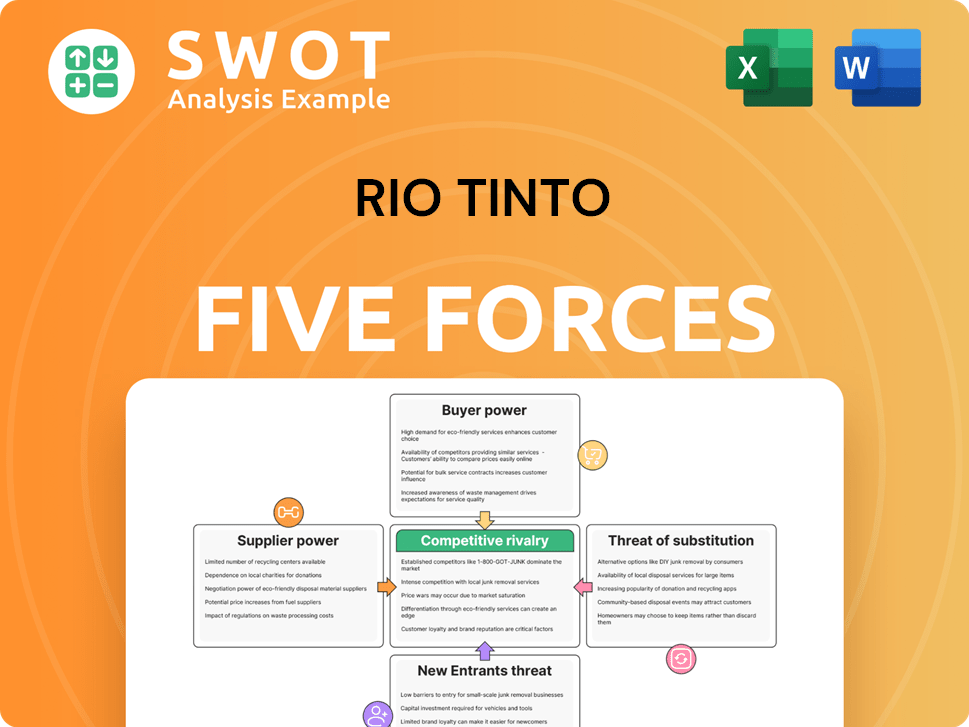
Related Blogs
- What are Mission Vision & Core Values of Rio Tinto Company?
- What is Competitive Landscape of Rio Tinto Company?
- How Does Rio Tinto Company Work?
- What is Sales and Marketing Strategy of Rio Tinto Company?
- What is Brief History of Rio Tinto Company?
- Who Owns Rio Tinto Company?
- What is Customer Demographics and Target Market of Rio Tinto Company?
Disclaimer
All information, articles, and product details provided on this website are for general informational and educational purposes only. We do not claim any ownership over, nor do we intend to infringe upon, any trademarks, copyrights, logos, brand names, or other intellectual property mentioned or depicted on this site. Such intellectual property remains the property of its respective owners, and any references here are made solely for identification or informational purposes, without implying any affiliation, endorsement, or partnership.
We make no representations or warranties, express or implied, regarding the accuracy, completeness, or suitability of any content or products presented. Nothing on this website should be construed as legal, tax, investment, financial, medical, or other professional advice. In addition, no part of this site—including articles or product references—constitutes a solicitation, recommendation, endorsement, advertisement, or offer to buy or sell any securities, franchises, or other financial instruments, particularly in jurisdictions where such activity would be unlawful.
All content is of a general nature and may not address the specific circumstances of any individual or entity. It is not a substitute for professional advice or services. Any actions you take based on the information provided here are strictly at your own risk. You accept full responsibility for any decisions or outcomes arising from your use of this website and agree to release us from any liability in connection with your use of, or reliance upon, the content or products found herein.